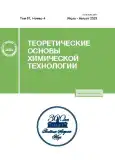Digital Twins for the Porous Structures of Aerogels with the Use of the Cellular Automation Approach and Bezier Curves
- Autores: Lebedev I.V.1, Ivanov S.I.1, Safarov R.R.1, Men’shutina N.V.1
-
Afiliações:
- Mendeleev Russian University of Chemical Technology
- Edição: Volume 57, Nº 4 (2023)
- Páginas: 412-418
- Seção: Articles
- ##submission.datePublished##: 01.07.2023
- URL: https://journals.rcsi.science/0040-3571/article/view/138510
- DOI: https://doi.org/10.31857/S004035712304005X
- EDN: https://elibrary.ru/VIZFKX
- ID: 138510
Citar
Texto integral
Resumo
In this paper, a cellular automation model developed on the basis of Bezier curves with the use of a cellular automation approach for the creation of digital twins for porous nanostructures of different nature is proposed. Some numerical experiments on the creation of digital twins for the synthesized experimental samples of chitosan-based aerogels are carried out. The structural characteristics of the digital copies and experimental samples are compared, allowing us to conclude that the model is correct. The resulting digital twins can be used for predicting the properties of porous fiber materials, in particular, chitosan-based aerogels, to provide the partial replacement of real experiments by computational ones and, consequently, to decrease the expenditures on the development of new materials with specified properties.
Palavras-chave
Sobre autores
I. Lebedev
Mendeleev Russian University of Chemical Technology
Email: chemcom@muctr.ru
125047, Moscow, Russia
S. Ivanov
Mendeleev Russian University of Chemical Technology
Email: chemcom@muctr.ru
125047, Moscow, Russia
R. Safarov
Mendeleev Russian University of Chemical Technology
Email: chemcom@muctr.ru
125047, Moscow, Russia
N. Men’shutina
Mendeleev Russian University of Chemical Technology
Autor responsável pela correspondência
Email: chemcom@muctr.ru
125047, Moscow, Russia
Bibliografia
- Svyetlichnyy D.S. A three-dimensional frontal cellular automaton model for simulation of microstructure evolution—initial microstructure module // Model. Simul. Mater. Sci. Eng. 2014. V. 22. № 8. P. 085001.
- Krivovichev S.V. Algorithmic crystal chemistry: A cellular automata approach // Crystallogr. Rep. 2012. V. 57. № 1. P. 10–17.
- Kimber J.A., Kazarian S.G., Štěpánek F. Microstructure-based mathematical modelling and spectroscopic imaging of tablet dissolution // Comput. Chem. Eng. 2011. V. 35. № 7. P. 1328–1339.
- Pérez-Brokate C.F., di Caprio D., Féron D., De Lamare J., Chaussé A. 2014. Overview of Cellular Automaton Models for Corrosion. In Cellular Automata, ed J. Wąs, G.Ch. Sirakoulis, S. Bandini. 8751: 187–96. Cham: Springer International Publishing.
- Gurikov P., Kolnoochenko A., Golubchikov M., Menshutina N., Smirnova I. A synchronous cellular automaton model of mass transport in porous media // Comput. Chem. Eng. 2016. V. 84. P. 446–457.
- Brouwers H.J.H., de Korte A.C.J. Multi-cycle and multi-scale cellular automata for hydration simulation (of Portland-cement) // Comput. Mater. Sci. 2016. V. 111. P. 116–124.
- Bullard J.W. 2008. A Determination of Hydration Mechanisms for Tricalcium Silicate Using a Kinetic Cellular Automaton Model // J. Am. Ceram. Soc. 2008. V. 91. № 7. P. 2088–2097.
- Bonchev D., Thomas S., Apte A., Kier L.B. Cellular automata modelling of biomolecular networks dynamics // SAR QSAR Environ. Res. 2010. V. 21. № 1–2. P. 77–102.
- Menshutina N., Kolnoochenko A., Lebedev A. Cellular Automata in Chemistry and Chemical Engineering // Annual Review of Chemical and Biomolecular Engineering. 2019. V. 10. P. 325–345.
- Бандман О.Л. Клеточно-автоматные модели пространственной динамики // Системная информатика. 2006. Т. 10. С. 59–113.
- Бандман О.Л. Метод построения клеточно-автоматных моделей процессов формирования устойчивых структур // Прикладная дискретная математика. 2010. № 4(10).
- Lis M., Pintal L., Swiatek J., Cwiklik L. GPU-Based Massive Parallel Kawasaki Kinetics in the Dynamic Monte Carlo Simulations of Lipid Nanodomains // J. Chem. Theory Comput. 2012. V. 8(11). № 65. 4758 p.
- Lee H.W., Im Y.-T. Cellular Automata Modeling of Grain Coarsening and Refinement during the Dynamic Recrystallization of Pure Copper // Mater. Trans. 2010. V. 51. № 10. P. 1614–1620.
- Gandin Ch.-A., Rappaz M. A coupled finite element-cellular automaton model for the prediction of dendritic grain structures in solidification processes. Acta Metall. Mater. 1994. V. 42 № 7. P. 2233–2246.
- Miller W., Succi S., Mansutti D. Lattice Boltzmann Model for Anisotropic Liquid-Solid Phase Transition // Phys. Rev. Lett. 2001. V. 86. № 16. P. 3578–3581.
Arquivos suplementares















